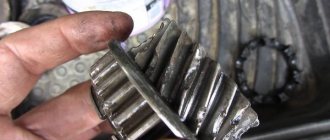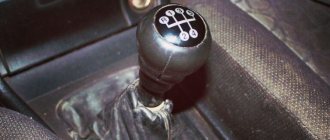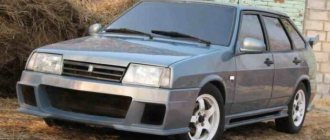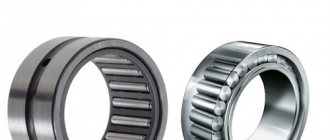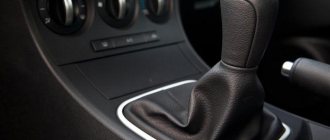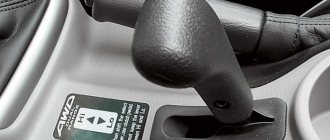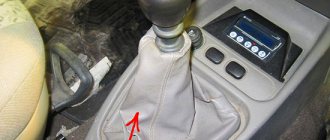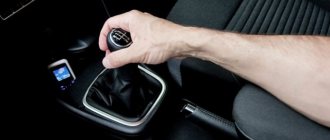good afternoon everyone. VAZ 2108 car, 2nd gear started to slip out, I’m sinning with the synchronizer. The synchronizer itself costs 300 rubles, but how much will it cost to repair it in a car service center? And how to avoid being spoiled? City of Samara. VAZ 2115 2nd gear slips out.
Similar articles
30 comments on “Vaz 2115 2nd gear slips out. 2nd gear started slipping out"
Fixator... the spring has sat down... I think it's about him
I was told all together 5-7 thousand. also most likely synchronous. Rostov
The 3rd VAZ 2113 took off, the repair cost 5500, labor and spare parts:) think for yourself) and it’s not a fact that it’s a lock) I also changed the clutches and synchronizers)
The problem is in the 1st-2nd gear clutch. Lately the 2nd with a crunch is ON.
Sin! Synchros have nothing to do with it, you can throw them away and drive without them! Clutch, fork, gear. one of three or all!
The synchronizer has nothing to do with it, it is only responsible for the smooth engagement of the gear. An autopsy will show. Also look at the cushion on the box, when I was 15 the cushion under the box tore, and it also knocked out gears when the engine rocked
In Samara, the boys themselves should be able to change this
The 2nd one also crashed on four, in the end the work cost 3 rubles, about 4 spare parts came out, synchronizers, bearings, gears, etc.
first change the retainer + pillows
Listen, you live near Kazakhstan, Ural, we are in the process of dismantling a new broken down car, you can buy a box for four rubles or make an old one for three
crashed on my eight. "new pillows" helped
Parsing everywhere in the city
Sergey, in Taganrog for 3.5 they made a kenta on the nine only the back
Dimon, well, I also talked about the second one
Sergey, it’s all about removing the gearbox and the synchronizer is crap, even the second one, even the rear one, remove it and put it on 3p
Dimon, I won’t argue) I don’t know) I’ll ask around again)
Hello, your clutch is screwed up and the 2nd gear may also be coming up, but you need to look at this, you can drive up, I’ll take a look, I’m at the satellite car service center
In Sochi 3.5 it costs to remove, reassemble and install back
In any case, disassemble the gearbox, then buy a set of bearings if you are going to shake it up. The first person will say thank you…..
To avoid getting screwed, do it yourself is the only surefire method.
They repaired the 3rd, on the 12th, 5t. R. Work + 3500 spare parts
Dima, your 2nd gear clutch has run out. There is a secret how to extend the life of a new clutch, and it will never fly out again
Evgeny, don't tear the box?
Dima, no, it will be possible to wind it up even more
Dima, because of the synchronizer, the transmission cannot take off, it only takes off due to licked teeth on the 3-4th gear clutch (or because of dinner with the ball, but this is a very rare case), due to a worn synchronizer, the gear either does not engage or is difficult to engage and with a crunch
It’s easier for you to disassemble the box and buy a new one!))
Why reverse gear does not engage - common reasons
In this article we will look at the main reasons:
Speed shifter
The first thing you need to pay attention to is the rocker itself and the cardan - it often happens that the rocker slips, the splines are ground off or the clamp is loose. In this case, you will need an overpass or a pit.
Reverse gear locking mechanism
To check this mechanism, you need to remove the gearshift knob (the dashboard between the seats) and look. Everything will become clear. If you checked the first two points and found no problems, then you will have to remove the gearbox. The fixing bolt was cut off. Fastening the gear selection mechanism. A spring (the most common one sometimes bursts).
Alternatively, the reason may be in the release bearing, but then all gears would be engaged barely and with a crunch. You can also try adjusting the clutch pedal.
If the VAZ 2109 does not turn on the speed, then there may be several reasons
Most often, owners of nines complain that the VAZ 2109 does not turn on the speed or there is a crunching noise when turning it on and moving backwards. First of all, analyze what you have recently changed in the box or clutch. Then remember the moment when deviations from normal operation appeared. Check the oil level.
Causes of gearbox failure
The complex mechanism constantly works under load and under extreme conditions. Constant vibration, rising temperatures, dust and dirt. If one or more speeds fail to turn on, you should check:
Clutch
It is typical for such wear that the clutch pedal falls to the floor and you can hear from drivers that the VAZ 2109 does not engage the gears. Usually this applies to all gears, but only first and reverse can fail.
You can check by removing the rubber plug. The destroyed disc leaves fibers that look like tangled strands of hair. If such a phenomenon occurs, then a new clutch disc should be installed.
Due to constant loads, the cable stretches and must be periodically adjusted and tightened. In this case, the VAZ 21093 does not engage the first and second gears, and the rear may also fail. To fix the breakdown, you need to drive into the pit and tighten the cable. If it is worn out, replace it immediately. You can do this yourself.
A similar breakdown can also manifest itself in the failure of the gears to engage while the engine is running. Sliding along the splines is limited and fixation does not occur.
Basket
The reason for difficult shifting of individual gears, especially if there is a crackling sound that gradually fades during movement, may be the destruction of the spacer ring in the basket
Notice that there are drops of oil on the outside. Then remove the basket and check the O-ring and disc blades
Pay attention when purchasing new parts, because on some models the disk is missing and then you have to install pins and secure it yourself.
Backstage
A loose link must be tightened with an assistant. No special knowledge or skills are required, just the ability to hold the lever in the desired position while you crawl under the car and tighten the bolts. When the scenes on the VAZ 2109 are loosened, the speeds do not engage, and especially the rear ones.
Place the car on a hole or hill to have access to the bottom. Set the lever to neutral if several speeds do not engage. When only the reverse gear does not work, make adjustments using it. An assistant must hold the shift knob in the specified position without moving it anywhere.
It is necessary to loosen the bolt from below by 13, check the engagement of the gears, and having installed everything in place, tighten the bolt. If there is a problem with several gears, everything is done the same way, but it is set to neutral, or rather the shift knob is in the middle position. You can watch the video on how to do this.
Why might there be such interruptions?
The gearbox of any car is one of the most important components of the vehicle. Breakdowns in it can occur both due to improper operation and due to driving on bad roads. If on your Priora the first gear does not engage well or does not engage at all, then this is due to a breakdown of the gearbox.
VAZ Priora car
If your car was purchased second-hand and not from a showroom, then there is nothing to be surprised about. In any car, sooner or later the problem of unstable gear shifting may arise. Moreover, if at the beginning of the problem the speed is turned on, but poorly, then in the future the gearbox lever may not respond at all to the driver’s attempts. Of course, this is not very pleasant, because not every car enthusiast can move from a stop in second gear, and the situation on the road does not always allow this.
Let's consider the main malfunctions that may occur when it is difficult to change gears in a VAZ 2170 car:
- incomplete disengagement of the clutch. On Priors, the mechanical clutch cable can fly off. This can be determined very quickly: if the cable breaks, then the clutch pedal in the car will simply be recessed into the floor;
- failure of the gear drive control rod;
- failure of jet thrust;
- the fastening screws on the hinge or lever of the speed selection rod have become loose for some reason;
- incorrect adjustment of the gearbox speed shift drive;
- The service life has expired or the plastic parts in the gearbox control drive have failed;
VAZ Priora gearbox disassembled
- the link is poorly adjusted. This device in the car performs the function of connecting directly the gearbox with the lever in the cabin. Also, the plastic bushings on the rocker may wear out;
- synchronizer malfunction. Synchronizers are brass bushings designed for easier gear shifting. Because brass is a soft material, it can wear away over time. To understand that it is the synchronizers that have failed, when it is difficult to switch gearbox speeds, you will regularly hear an unpleasant crunching or grinding noise. If you only hear sound from the gearbox, but the gears are switched without problems, then be prepared to soon encounter difficult gear shifting;
- bearing failure. The problem is not so common, even rare, but nevertheless occurs. If the manual bearings are jammed, then one of the gearbox shafts may stop rotating, as a result of which not all speeds can be engaged. As a rule, this problem only appears when first gear is engaged;
- gearbox shaft malfunction. This element is not subject to physical wear or heavy loads, but the problem may be a manufacturing defect. If minor errors were made during its installation at the factory, the shaft will fail. In this case, not only may it be difficult to engage the first gear, but the entire gearbox may fail. As a result, the vehicle owner is subject to expensive repairs.
It’s worth noting right away that there is no way to determine a faulty gearbox shaft or bearings at home. Only a competent technician at a service station with expensive specialized equipment will help you do this. Therefore, if you encounter problems shifting the gearshift lever, then you can only hope that the problem lies in the adjustment.
Gearbox lever of a VAZ Priora car without a casing
Repair or replacement
If, during checking the condition of the box, serious damage to its elements was revealed, then serious repairs cannot be avoided.
It should be immediately noted that independent dismantling, repair and reassembly of a gearbox requires not only very good equipment (nominally a pit or overpass, a lifting device, as well as a large set of tools are required), but also very serious knowledge.
That is why, if the gears of a VAZ 2114 do not engage, such repairs should be entrusted to specialists from car service centers.
It should be remembered that independent repair or replacement of the gearbox automatically leads to the loss of all warranty obligations from the manufacturer. For this reason, repairs to a car that is under warranty should be entrusted to branded repair shops.
If we talk about the choice between repair and complete replacement of the unit, then in most cases you should choose the first option. This is due to two reasons. Firstly, the cost of a completely new box exceeds 15 thousand rubles. (moreover, this amount is indicated without taking into account the cost of its installation). In any case, repairs will be much cheaper. And secondly, complete wear of the box (to a state unsuitable for repair) is extremely rare.
The cost of the repair work itself varies from service to service and depends on:
- the size of the locality (and, as a consequence, the presence of competitors);
- type of breakdown;
- the size of the car service (and whether it is official);
- additional clauses in the terms of the contract.
What to do?
Next, we will look at several ways to solve the problem that can be done at home. The process of repairing a transmission is not such a simple task, so if you are not confident in your abilities, then do not try to do it yourself. It is better to contact specialists, because if you make even a small mistake, it can develop into more serious problems in the future.
Tools
Regardless of what kind of breakdown you have, prepare in advance all the necessary tools that you may need to disassemble the gearbox:
- slotted screwdriver;
- a set of heads for unscrewing bolts;
- set of wrenches;
- mounting blade;
- hammer;
- pliers with thin jaws;
- Phillips screwdriver;
- Litol lubricant;
- jack;
- container for draining transmission oil from the gearbox;
- technological plug for the hole in your robotic gearbox. A set of tools for dismantling and repairing the VAZ Priora gearbox
Removing the manual transmission
- First of all, before disassembling the gearbox, it is necessary to drain the transmission fluid from the gearbox. To do this, find an oil drain hole under the bottom of the vehicle, place a previously prepared container and unscrew the plug. Wait 40-60 minutes until the oil is completely drained. Now you can begin dismantling the gearbox.
To begin, find in the cabin under the instrument panel the fastening nut of the clutch cable housing, which is connected to the pedal. It needs to be unscrewed. To do this, you will need an "8" socket or wrench. When the nut is unscrewed, remove the stop from the bracket.
- Then you need to dismantle the locking element and the housing of the wear compensation device for the driven shaft linings from the clutch pedal pin. To do this, take a slotted screwdriver and pry out the element.
- Now remove the plastic bushing from the pedal and then inspect it. If the bushing shows signs of wear or any physical damage, the bushing should be replaced. Before installing it directly, take “Litol” and lubricate the element so that it does not become dry.
- Next, dismantle the rubber seal of the clutch pedal cable sheath - it is located in the engine compartment.
- Then you need to remove the end element from the cable fork, after pulling it forward in the direction of travel of the vehicle.
Repair or replacement
If, during checking the condition of the box, serious damage to its elements was revealed, then serious repairs cannot be avoided.
It should be immediately noted that independent dismantling, repair and reassembly of a gearbox requires not only very good equipment (nominally a pit or overpass, a lifting device, as well as a large set of tools are required), but also very serious knowledge.
That is why, if the gears of a VAZ 2114 do not engage, such repairs should be entrusted to specialists from car service centers.
It should be remembered that independent repair or replacement of the gearbox automatically leads to the loss of all warranty obligations from the manufacturer. For this reason, repairs to a car that is under warranty should be entrusted to branded repair shops.
If we talk about the choice between repair and complete replacement of the unit, then in most cases you should choose the first option. This is due to two reasons. Firstly, the cost of a completely new box exceeds 15 thousand rubles. (moreover, this amount is indicated without taking into account the cost of its installation). In any case, repairs will be much cheaper. And secondly, complete wear of the box (to a state unsuitable for repair) is extremely rare.
The cost of the repair work itself varies from service to service and depends on:
- the size of the locality (and, as a consequence, the presence of competitors);
- type of breakdown;
- the size of the car service (and whether it is official);
- additional clauses in the terms of the contract.
Clutch basket
Over time, the clutch basket fails on all cars with a manual transmission. Sometimes it’s due to wear and tear, sometimes the petals or the so-called “spider” break. Let me start, perhaps, with the “spider”, this is a mechanically fixed release bearing on several extensions (done like this on some VAZs), if the extension breaks, then it cannot be effectively fixed to the basket - the gears do not engage.
Next, the petals of the box break, or they become weakened. This leads to the fact that it is very difficult, almost impossible, to release the clutch disc. Therefore, the “speeds” do not switch – we just change the basket.
Well, the last wear and tear is the basket disk. It has a metal disk inside, and over time, especially from high mileage, wear forms there. When starting, the car will shake, and if the wear is very large, the gears may not shift.
In any case, we need to change the clutch basket.
Second gear of VAZ 2114 fails for reasons
Moderator: Rustem
2nd gear of VAZ 2105 falls out
For 5 years the factory box behaved perfectly. but yesterday I was driving 2 slowly and out of the blue it crashed and flew out with a crunch. after which every time if you don’t hold the lever while switching to 2, it flies out. But it is worth holding the lever and completely releasing the clutch. and the transmission stays in place and does not crash. After the first flight the box does not crunch.
Help whoever can. and most importantly if anyone knows how. describe the repair process and the necessary spare parts in artisanal conditions.
Unread message Alex » Wed Jul 29, 2009 11:00:31
Unread message vopikan » Wed Jul 29, 2009 14:13:01
Unread message from Olezhek » Thu Jul 30, 2009 6:19:35 AM
gear locks. we're talking about them.
good article again from nivovodov
People believe nothing so firmly as what they know least about, and no one speaks with such self-confidence as writers of all sorts of fables - for example, astrologers, fortune tellers, palmists. Religion, superstitions. Michel Montaigne
2nd gear crunches and slips out
And so, after two days of torment, I removed and disassembled the 5-speed gearbox of the VAZ 2107i
As I wrote in another topic, I found only two breakdowns: 1 - the tendril on the clutch fork was broken off 2 - the input shaft bearing was damaged. But after I washed the input and secondary shafts with their gears, 2 jambs were noticed 1 - on both synchronizer couplings there are small chips on the teeth 2 - due to these chips, a track has formed on the locking rings of the second and first gear synchronizers on the clutch side. In first gear I just shuffled a little, there are no ruts yet.
The question is, could this affect the sound when turning on and the transmission slipping?
Re: 2nd gear crunches and slips out
Unread message by Mizhgan » Wed Sep 26, 2012 13:56:09
Re: 2nd gear crunches and slips out
Re: 2nd gear crunches and slips out
Unread message mik58 » Wed Sep 26, 2012 14:11:28
First gear is not engaged when driving
Often when you put the car into first gear while the car is moving, it gets stuck and doesn't work. Once you start moving there is no problem. Some "experts" have even theorized that first gear should just start moving and should not be used during maneuvers.
This problem occurs because the injectors do not have time to equalize the torque of the gears, and the driver forcibly tries to connect them. The flywheel rotates much faster than the drive shaft and the teeth can fly if the force is high.
Don't be in a hurry to press the lever. Move it to neutral, push it lightly into the first gear position and wait for the synchronizers to do their job and the transmission begins.
READ Where is the Fuel Filter Citroen C4 Gasoline
For old boxes there are instructions for replacing gas. When downshifting while driving, move the lever to neutral, press the accelerator to increase speed, and then shift smoothly. This method is used by owners of preserved vintage cars, the price of which has increased significantly in recent years.
Source
As you already understood, we will talk about a manual “box” and about shifting gears (or rather not shifting) to it. I have a lot of experience in this area, I have personally repaired cars such as VAZ 2114, VAZ 2110 (and indeed the 10th family). To say that foreign cars have global differences, so they are special. NO! So, if your speeds are not "cut off", the reasons may be similar. In general, the article will be useful, in the end, as always, the video.
God comes to me with so many questions, especially from novice drivers of our VAZ! Especially with front wheel drive, because the rear wheel drive lever was installed in a manual transmission. I want to answer everyone right away. the problem of non-inclusion may not always be cardinal! Often these are small things, just from time to time something shakes or unscrews, as a rule, this happens in 50% of cases.
Therefore, I will try to break the material into two main components. simple and complex faults.
I suggest starting with simple mistakes.
Common gearbox problems
Owners of the VAZ 2110 car note several characteristic faults in gearboxes for this model. Some people do not engage reverse gear, others complain about overshoot, and so on.
Let's look at the most popular problems that the domestic "ten" box can boast of.
- First speed problem. It may fly out or be difficult to turn on in the car. There are several reasons: The synchronizer has failed;
- The latch spring has a defect, it has burst;
- The lever has become loose, causing the gears to switch spontaneously;
- The rod is out of order or the fork is faulty; they must be replaced.
Second gear problem. It often gets knocked out, or it’s difficult to switch to it. There may also be several reasons for such a malfunction:
- The gear teeth do not cling well to the gear shift clutch;
The tips of the teeth are worn out and worn out, making it difficult to switch on the speed. Over time it will begin to fly out. Therefore, repairs are required; If the gear is knocked out when hitting a bump, then there is nothing good about it - the problem lies in a failing clutch.
Having experience, relevant knowledge and skills makes it possible to deal with checkpoint problems with your own hands. If all this is missing, we strongly recommend that you contact a trusted service center, where they will carry out diagnostics, determine the true causes of the problem and return your gearbox to its previous condition. Yes, it will cost some money, but you can’t do without it. Nothing is eternal. Moreover, the “tens” gearbox.
Source
Extending the service life of gearboxes
You will be able to use your car for many years without going to car repair shops if you can follow basic recommendations. They will extend the service life of the gearbox, minimize possible problems, breakdowns and the need for repair work.
Transmission shaft assemblies
There are only two recommendations.
- Always try to monitor the oil level in the gearbox. If it drops, be sure to top it up immediately, do not delay the procedure until later. When the oil becomes unusable, change it completely, rather than fill in the missing amount.
- Avoid aggressive use, do not jerk the gears sharply, accelerate smoothly, and brake similarly. A simple caring attitude towards the gearbox will allow you to avoid wear and tear and numerous breakdowns.
As you can see, solving problems with checkpoints is not so easy. Therefore, the best option is to prevent their occurrence.
Types of checkpoints
Today, all cars are equipped with one of three types of gearboxes.
- Mechanical. Speed shifting is done manually using a special lever.
- Automatic. No external influence is required to change gears. Switching is carried out depending on the degree of pressure on the brake and gas pedals. In this case, reverse gear is engaged manually.
- CVTs. This is a mixed type of gearbox, where the bulk of the work is performed automatically, but if necessary, the gearbox is switched to manual mode.
Replacing and adjusting the gearbox driveshaft
So, if only reverse does not work, and all other modes do not fail, then you will need to replace the universal joint and adjust it. To do this, prepare a new spare part, a gear selector shaft seal, a set of keys, a hammer and several screwdrivers of different sizes.
Carry out the work according to the instructions:
Place the machine on an overpass or over a pit. Find the gearbox from below and loosen the clamp bolts on its drive rod. Remove the actuator completely from the stem. Using a screwdriver, pull the boot towards the unit. Often the boot is completely damaged during this step, in which case it can be removed and then a new one installed
Unscrew the fixing screw on the universal joint. Carefully tap the driveshaft off the assist shaft with a hammer. Remove the boot if you haven't damaged it previously
Install a new oil seal on the speed shaft. Install a new boot, place the cardan on the shaft so that the position of the fixing screw coincides with the recess on the shaft. Tighten the retaining screw and place the rod on the rod, but do not tighten the clamp. To make the adjustment, ask an assistant to move the gearshift lever to the neutral position and a short distance to the right. He should hold it in this position while you tighten the clamp.
If the reason for the failure of the reverse gear was hidden in the cardan of the carriage, then you will no longer have problems after this repair.
Troubleshooting
Many transmission malfunctions that cause the reverse gear to disappear or fall out can be eliminated without removing the unit from the car.
If the cause is a loosening of the bolt securing the clamp on the rod, then to correct the defect it is necessary:
- Place the car on a lift.
- Completely loosen the clamp nut.
- Place the gearshift lever in the fully engaged reverse gear position.
- Fully engage reverse gear at the gearbox using the shift rod on the crankcase.
- Tighten the clamp mounting bolt.
Backstage adjustment
If tightening the clamp does not help get rid of the problem, then you need to check the condition of the shift drive parts. One of the reasons why the reverse gear does not engage may be a poorly adjusted rocker.
To make adjustments to the mechanism, you may need the following tools:
- two wrenches with a size of 13 mm, preferably a socket design;
- any wrench or 10 mm socket;
- small hammer;
- slotted screwdriver.
Since the cause of malfunction of the link can be wear of parts, spare parts may be needed:
- universal joint of the rocker;
- Sometimes the shift rod seal may need to be replaced.
Two people are required to adjust the rocker or replace parts of its drive. One person must change gears from the passenger compartment, and the second must adjust the travel of the shift rods.
The order of work is as follows:
- Provide access to the bottom of the car by placing it on a pit or a lift.
- Using a 13 mm wrench, loosen the clamp installed on the gear shift rod.
- Remove the rod from the box rod.
- Using a screwdriver, carefully remove the boot.
- Using a 10 mm wrench, unscrew the fixing bolt on the cardan shaft.
- Knock off the cardan shaft with light blows of a hammer. It is important not to damage the shaft.
- Remove the universal joint seal boot.
- If there is an oil leak, the sealing gland on the box rod must be replaced.
- Install a new boot (or leave the old one if it is intact) and install the universal joint on the shaft.
- Align the hole on the cardan with the notch on the shaft.
- Tighten the 10 mm clamp and install the boot completely in place.
- Install the rod on the cardan rod and adjust the gearshift lever travel.
- The second person should sit in the driver's seat, set the gear shift lever to neutral, move it slightly to the right and hold it in that position.
- After this, you need to tighten the 13 mm clamp nut.
Typically, after such a repair, the reverse gear starts to engage without problems. In addition, the operation of the entire gear selection mechanism on the VAZ-2109 becomes clearer.
Replacing the backstage
Changing the gearbox oil
If the oil seal on the rod is damaged, oil leaks out of the gearbox housing, and dirt can get into the box itself. These factors may be the reason why reverse gear stops engaging. In addition, the oil in the box loses its properties during operation, so it must be replaced preventively at least once every 35–40 thousand kilometers. Before replacing, you need to check the condition of the oil in the box. To do this, you need to remove the oil dipstick installed in the gearbox housing and visually assess the quality of the oil. The presence of metal and dirt particles in the oil on the dipstick is unacceptable. The oil itself should be quite liquid and not stick to your hands in a thick layer.
To replace, you will need the following materials and tools:
- New oil. When purchasing oil, you need to consider the type of gearbox. For fairly rare four-speed gearboxes, three liters of oil are required, for newer five-speed ones - 3.3 liters. The oil itself must have a tolerance of 80W-85, the manufacturer does not matter.
- A container for draining old oil with a volume of at least 4 liters.
- A funnel with a hose for pouring new oil or a syringe.
- Wrenches 12 and 17 mm of any type.
- Rags and cleaning solvent.
The actual work order is as follows:
- Place the car with the heated gearbox on the pit.
- Remove the rubber plug from the gearbox ventilation valve installed on the top of the crankcase.
- Clean the valve and plug from dust and dirt. It is convenient to clean parts with thin wire and a rag.
- Reinstall clean parts.
- Wipe off dirt from the bottom of the box. Unscrew the plug on the bottom of the box housing.
- Place a container under the drain hole and drain the oil. It will completely merge in at least 20-25 minutes.
- After this, screw the drain plug back into place and carefully tighten it with a wrench. First, the plug and hole must be thoroughly wiped with a rag.
- Pour fresh oil through the oil level dipstick hole in the box.
- During filling, it is necessary to check the oil level, which normally should be between o and “MAX” on the dipstick rod.
- If there is an overflow, the oil can be pumped out with a large medical syringe with a tube on the spout.
- Within a few days after the change, it is advisable to check the level and appearance of the oil. You also need to make sure that there are no leaks through the plug and box seals.
Causes
The reasons why reverse gear engagement is poor or difficult may be as follows:
- loosening of the fastening clamp of the rocker, due to which the length of the rod is not enough to fully engage the gear;
- jamming of the reverse speed lock;
- spring breakage and debris getting into the guide grooves of the gear selection mechanism;
- spontaneous loosening of the selection mechanism mounting bolts;
- the clamp bolt is cut off;
- wear of the clutch disc and release bearing;
- incorrect adjustment of the clutch and clutch pedal;
- low oil level in the box or the need to replace it.
New or refurbished old?
If replacing the gearbox cannot be avoided, it is worth considering one very attractive option - installing a rebuilt gearbox. To do this, companies purchase old, damaged boxes, restore them to the highest possible quality and offer installation with a guarantee.
Disassembled gearbox
As practice shows, such gearboxes are approximately 30-70% cheaper than purchasing a new gearbox.
There is only one important condition for successful savings on such significant repairs. It must be a reliable, trusted company
Such companies value their own reputation, so they do not deal with fakes or low-quality repairs. In order to receive positive customer feedback and attract new customers, they simply must do everything well, conscientiously. That’s why today there are fly-by-night companies and companies where, over the years of work, they have established themselves as a reliable and responsible specialist in repairing and replacing gearboxes. You yourself understand perfectly well who you need to contact if you have problems with your box.
Repair and replacement
It is quite difficult for novice motorists to even simply determine why their gearbox is not working. What can we say about replacing the gearbox seal on a VAZ 2114, which requires a certain skill and knowledge in the field of car repair.
Unfortunately, if you ignore the initial signs of a gearbox malfunction, this may result in a full-fledged need to replace the entire unit. Many are even afraid to ask the current cost of a new gearbox for the “fourteenth” model. But we will say. Today such a unit will cost you at least 15 thousand rubles. Moreover, this price does not include installation services. Changing an entire gearbox yourself is not an easy task.
Let's be frank. Situations in which a car is rendered unsuitable for transmission repair are very rare. Most often, something like replacing the gear selector rod seal on a VAZ 2114, gears, levers and other components is required.
It is difficult to carry out diagnostics on your own in a garage environment. To correctly identify a breakdown, you will need at least a lift and a driver’s extensive experience in car repair. But it is best to carry out diagnostics at a car service center with the appropriate equipment. Whether you entrust them with the repairs or handle this stage yourself is up to you.
Opening the black box or treating reversing lights
I’ve been making frequent recordings in recent days, but it’s empty and thick :-D, but oh well, today we’ll talk about how I struggled with the reverse lights.
About two months ago, when the tree was still standing, I took it to the car wash, washed up all right, drove it home, left the car behind the fence and went home. In the evening I went to drive the car into the garage, I turned on the rear and my tidy went out, the side and the rear too. . . What the f*ck did you think, let’s run to GOOGLE, they say fuse, look, idiot. . I look at the fuse and it’s not a thorn.
Here it is F16 - highlighted in red
I put another one on and turn on the rear one and the same story, well, that means the black box lock (aka fuse block or fuse box) I should have thought of sticking it under the drain. . . on the street there was no desire to fiddle with an oak tree with a block, and the wires were oak, so I took the easier route, threw the chip off the sensor and forgot about it, washed it down, and killed it. . . You can drive like this, of course, but it’s not comme il faut, especially in a parking lot when you’re driving and people don’t even know which way. Today I began to solve this problem, first I found out which contacts of the fuse block the wires from the sensor go to (Base X6, contacts 2 - green and 12 - orange), threw off the CYA, took this block and rang the wires to the sensor with a multimeter for a short circuit (a goat in the people) , the wires are fine, let's continue digging. I took it apart and let’s see what’s wrong where, in principle, all the normal tracks have not oxidized, there’s nothing to short-circuit either, but it’s one thing to just look and another to call and make sure that everything is fine here. To dial the tracks I had to delve a little into the diagram. From the diagram it follows that “+” goes from fuse F16 to the 12th contact of the X6 block and goes to the sensor (orange wire), passing through the sensor it returns to the 2nd contact of the X6 block (green wire) and from it goes to the X9 block Pin 16 (Output for reversing lamps)
I sketched out what goes where
Connection of blocks X6 and X9
You can see from the photos and the diagram that everything is simple here, I called, everything is fine, there is no goat, I started looking further. . . I dismantled the rear lights, maybe there is a goat walking from them and butting, but here too everything is in order, no hints of a goat, the wire from the CY to the lights rang, everything is also in order. . . Then great thoughts began about where and what could be. . . After sitting, thinking about it, weighing all the arguments and evidence, I decided to check the sensor itself, because... The fuse blows only after reverse gear is engaged, everything is in order in the control unit and wiring. I rang the contacts on the ground sensor, everything is fine and I started thinking again. . . then something pulled me to turn on the reverse gear and ring IIIIII BINGO again, one contact in the on state goes to ground!
Here it is, the green wire contact
How are car wash and reverse gear sensor related? There are mudguards in the engine compartment; a jet of pressure simply could not get to the sensor and damage it! I don’t understand shit at all. . . but the fact remains that the sensor needs to be replaced. I changed the sensor, assembled the fuse box, stuck it in place and here is the result
” />
Everything works great
Literally a week before, the dimensions on the left side and the lighting in everything in the cabin disappeared, the fuses were intact, the problem turned out to be in the CY
The solder contact spot between the bottom board and the top board is highlighted.
The soldering was oxidized and the output was only 5 volts instead of 12, 5 minutes of work with a soldering iron, two strokes of nail polish and everything returned to normal)))
To everyone who finished reading this entry, my respect, because not everyone will read this dregs))) Of course, it was possible to write everything in short, but I don’t like writing like “I spat, stuck it, put it on top with tape,” and I wanted to tell the full story of my misadventures!) ) So don’t rush to immediately throw off the fuse block and tear it to pieces, everything may turn out to be much simpler))) Learn from other people’s mistakes)))
Thanks Dislike Marty 05 Jan 2008
That’s it, the end has come! The clutch pedal has failed, the clutch has fallen apart! Now we can’t do without repairs, so I’m thinking about installing a new box or repairing this one with some modernization? What do you think? What will be cheaper?
Happy New Year, sir! You know, I’m always interested in the first question - how do you drive? I don’t want to itch and be known in the forum as a “smart guy” BUT. You can kill a Maybach in a day, or you can drive a “penny” for 30 years. Based on the riding style and accordingly put the salary on your horse. Sporty - install ceramic clutches, Brembo brakes, lei 98, average - install conveyor or, if you have the appropriate income, better e/p. But this is my personal opinion, without claims to absolutes.
https://www.zr.ru/content/articles/911224-neispravnosti-mkp-pochemu-stal/https://uremont.com/publications/articles/pocemu-vyletaet-vtoraa-peredacahttps://xn--2111 -43da1a8c.xn--p1ai/forum/viewtopic.php?id=2080https://www.semerkainfo.ru/forum/viewtopic.php?t=11801https://www.lada-forum.ru/index.php? showtopic=13659
Reverse gear does not engage: common breakdowns
So, if engaging reverse gear is difficult or completely impossible, this breakdown is a common problem that can be encountered in different vehicles when changing gears.
Moreover, the rear does not engage both on manual and automatic transmissions (the reverse speed of the automatic transmission has disappeared)
Naturally, in such a situation, it is important to discover the cause of the malfunction and eliminate the breakdown, since it is simply impossible to operate the car normally without reverse gear (the vehicle is actually deprived of reverse gear). Let's figure it out
Let's start with a manual transmission and consider the question of why reverse gear does not engage in a manual transmission. First of all, with a manual transmission the reverse gear fails much more often than with an automatic transmission. As a rule, the first signs of problems are a grinding, crackling or crunching sound in the reverse gear when engaged, the reverse gear is difficult to engage, it is difficult to engage the speed after a while, etc.
As for the main malfunctions, we can highlight the following:
The clutch does not disengage completely. As you know, the clutch connects the engine and the gearbox, and at the moment of changing gears the driver must depress the clutch pedal and “disconnect” the internal combustion engine from the gearbox. After engaging the gear, the pedal is released, the clutch “closes” and the torque is again transmitted to the wheels.
So, if the clutch is not completely disengaged, the gearbox is not completely disconnected from the engine. This leads to the fact that all gears are difficult to engage. At the same time, on many cars, first speed and reverse do not have synchronizers. As a result, clutch problems are most noticeable when engaging reverse gear.
In such a situation, when trying to engage a gear, a crunching and grinding noise is heard in the box
To eliminate the breakdown, you need to pay special attention to the clutch (condition of the clutch disc, basket, release bearing, etc.). You also need to check the clutch adjustments, the quality of the pedal, etc.
The oil level in the gearbox is low or the gear oil has lost its properties. As practice shows, there is a common misconception among drivers that the manual transmission is filled with oil for the entire service life of the car. In fact, a maximum of 100 thousand km. Even the highest quality gear oil becomes unusable. And this is subject to fairly gentle operation.
If the car is used in difficult conditions (driving around the city, irregular pace, constantly switching speeds “up” and “down”, short trips, temperature changes, etc.), then the oil in the box requires replacement every 50-60 thousand. km. The fact is that the properties of the liquid change, additives are activated, dirt, products of mechanical wear of the box and various deposits accumulate in the oil.
The gearbox linkage needs to be adjusted; the rods or gearbox drive levers are deformed. Often, it is after diagnosing the condition of the rocker that it becomes clear why reverse gear on a Lada and various foreign-made cars (especially old ones or with high mileage) does not engage. Owners of front-wheel drive VAZ models are well aware that a poorly adjusted rocker is the reason why the reverse gear does not engage or is knocked out.
The solution in such a situation is to adjust the manual transmission gate, which can significantly improve the clarity of the inclusions and obtain the necessary softness. Also, in some cases, owners remove the standard mechanism and install a short-throw slide, but in this case you need to be prepared for the need for more careful adjustment. As for the gearbox rods and drives, these elements must be inspected for possible damage or breakage, after which they are replaced.
Design features of the gearbox. Often on budget cars, reverse and first gears do not have synchronizers. The absence of these elements, on the one hand, simplifies the design of the box, but on the other hand, difficulties arise when engaging reverse gear and first speed.
Second gear of VAZ 2114 fails for reasons
Any gearbox has a complex structure with many interconnected parts, and the failure of even one part immediately affects the performance of the gearbox as a whole.
So often the cause of a gearbox malfunction is such a breakdown as one of the speeds being knocked out.
In this article, we will look at the main reasons for the question of why transmissions fail.
In order to make it easier to understand the reason for knocking out a certain speed, you need to briefly consider the principle of operation of the gearbox.
How does a manual transmission work?
A conventional manual gearbox consists of 3 shafts. These are the primary, intermediate and secondary shafts. The secondary shaft is located coaxially with the primary shaft, inside which there is a bearing into which the end of the secondary shaft fits, allowing it to rotate independently of the primary.
The intermediate shaft is a single unit with gears cast on it. It has a rigid connection through a gear to the input shaft, which causes it to rotate along with the gears of the gears.
When the gearshift knob is in neutral and the clutch pedal is not depressed, the input and intermediate shafts rotate.
On the secondary shaft of the gearbox there are gear blocks, 1st and 2nd, as well as 3rd and 4th, 5th gear and reverse gear are usually located in the rear compartment of the gearbox housing.
The blocks, in turn, consist of a hub, a gearshift clutch and 2 synchronizers. The hub has splines inside, the same as on the secondary shaft, thanks to which it can move forward or backward, depending on the gear engaged.
The couplings have a groove on top where the gear shift fork is installed. The fork itself is rigidly mounted on a slider, which is mechanically connected to the gear shift knob. The slider has three recesses into which a spring-loaded ball fits to fix the slider either in the neutral position or in the position of one of the speeds for which it is responsible.
As mentioned above, the secondary shaft also contains gears 1.2.3 and 4, which are in constant engagement with the gears on the intermediate shaft. The gears have a loose fit on the output shaft and rotate around the shaft without engaging with it.
When any of the speeds is turned on, the hub with the clutch on it moves along the shaft splines towards a freely rotating gear, for example, 1st gear and, thanks to the synchronizer, blocks it, forcing the secondary shaft to rotate.
The secondary shaft is rigidly connected to the drive to the drive wheels; this can be a cardan on a rear-wheel drive car, or a CV joint in a front-wheel drive version. The rotation of the shaft is transmitted to the drive, which in turn drives the drive wheels, causing the car to move.
Reasons for speed loss:
• Wear or breakage of the synchronizer blocking ring;
• Worn shift fork;
• Loosening of the gearbox fastening to the clutch housing;
• Wear on the clutch or gear teeth of one of the gears;
• Loosening the secondary shaft shank nut;
• Wear of the blocking nuts of the sliders or grooves in the body of the slider;
• Breakage of the springs of the slider fixing balls;
• Wear of the input shaft gear;
• Misalignment of the gear shift link in the slider drive.
When the driven shaft shank nut is loosened, the shaft gains freedom of axial movement, and the clutch may disengage with the speed gear ring and be knocked out.
A similar effect can be observed when the “legs” of the power fork wear out. When the fork wears out, it becomes free to move in the coupling groove, which also leads to the gear being knocked out.
Loosening of the shank nut and the appearance of play in the gearbox leads to accelerated wear of the teeth of both the couplings themselves and the teeth of gears and synchronizers. All this is caused by the inclusion of speeds with an impact due to the large stroke of the blocks on the shaft, which causes one of the speeds to be knocked out (usually the 4th).
Knockout of a gear or the inability to engage it is caused by wear or breakage of the synchronizer ring.
When the fastening of the gearbox handle drive shaft with the gearbox slider is loosened, the gear is not engaged, which also leads to one of the speeds being knocked out.
Rapid wear of gearbox elements is facilitated by a sharp start of the car with the clutch thrown, acceleration at full throttle and a sharp stop, plus incomplete engagement of the gear due to a worn or unadjusted clutch.
Dirty oil or its insufficient level also contribute to the wear of the gearbox , which is especially dangerous when there is a 5th gear, which, as a rule, is starved of oil and quickly fails. Dirty oil or a lack of it will also shorten the life of the gearbox shaft bearings.
Dirty oil is especially critical for automatic transmissions, where sometimes a simple oil and filter change helps get rid of the problem of gear slippage. In particularly advanced cases, it is necessary to clean or replace the hydraulic plate and solenoids; this will help if the mechanical part of the gearbox is in working order.
To monitor the gearbox and extend its service life, it is recommended to periodically check the tightness of the gearbox shank nut, the reliability of fastening the gearbox to the clutch housing, and the fastening of the gearbox mount (traverse). It is also necessary to check the condition and level of transmission oil and top it up or replace it if necessary.
A manual transmission is considered to be a model of reliability compared to various types of automatic transmissions, in which the choice of gear is controlled by an electronic brain. But there are spots in the sun too. Let's talk about one fairly common defect - gear knockout.
Determining a defect is so simple that it does not cause difficulties even for beginners. If a person knows more or less how to drive a car with a manual transmission, he will immediately understand that he engaged the gear, started to drive it, but suddenly problems occurred. Acceleration disappeared, the speed dropped, and the gearbox control lever itself ended up in neutral. Switching the same gear again gives the same result. The only way to continue driving in this gear is to forcefully hold the shift lever in the desired position.
Thanks Don't like aleks77 21 Dec 2007
There are relatively few hassles, but if you already know how to remove them. It’s better to take an assistant and work in the pit; you can do it without it, but it’s more inconvenient.
I tried to remove the box myself, everything was done according to the instructions, the three of us did it. they evaporated, the body was broken when they tried to knock out the wheel drives, and besides, everything was worn out. In the end, everything was collected as it was and we went to the service center. And there they were amazed at how cleverly they do everything, in general the advice is this: if you have a friend who has already encountered boxes, you can try to remove them. and the first time, in my opinion, is better to go to the service, I was a 41st Muscovite before - I went through it twice, and no such problems arose, but here for this bolt - one special key - for that another. for example, turn the starter key to 15! needed. These are the pies (by the way, after repairs at the service center, the case was covered with cold welding, so far it’s holding up)
